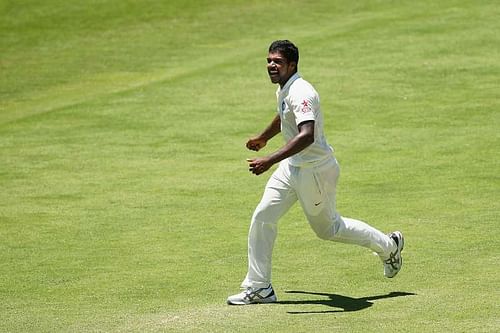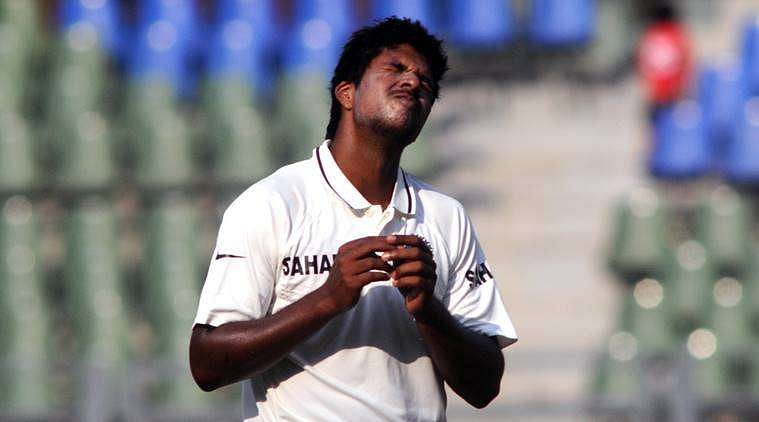
Varun Aaron: A lost talent
In the year 2004, a talent scout spotted a confident youngster in Jharkhand bowling at a phenomenal pace. As it was not a regular sight to see a youngster in India who could bowl at such pace, he was inducted into the MRF Pace foundation in Chennai, and as he grew older, stormed his way into the Jharkhand and East Zone U-19 sides.
With the amount of pace he generated and with his smooth run-up and repeatable action, he was destined to be the next big thing in Indian cricket. Fast forward to today, and he is struggling for a place in the Indian team, despite bowling at an average speed of 150 kmph.
Where has it all gone wrong for the man from Jharkhand?
No extra ingredient
Varun Aaron ticks all the boxes when it comes to sheer pace, but does not have much to boast about. He is not able to swing the ball, and not able to make much of the new ball, both in Tests and ODIs. Another problem with his bowling is that he hits the deck hard, just like Morne Morkel. While walloping the deck should not be an issue, the problem with it, especially on Indian pitches is that the ball does not bounce as much as foreign pitches; and when he does the same outside India, his erratic line, and length certainly does not help his case.
He lacks the control and bowling nous, which is present in the current Indian pacers like Mohammed Shami and Bhuvneshwar Kumar. While Bhuvi specialises in swinging the ball into the right-handers and away from the left-handers, Shami is well known for pace, accuracy, and skill in moving both old and new ball. In contrast to these two bowlers, Aaron is missing a secret ingredient in his bowling.
Another big issue for Aaron is his line and length. He is not able to maintain a consistent line and length and is very erratic due to which, he has not been able to bowl well during the death overs in the shorter formats of the game.
Constant injuries have hampered his ability
Over the years, Aaron has suffered from recurring stress injuries. He has gone through seven stress fractures, the first dating back to 2008, and had to undergo surgery to set a vertebra right. He continues to go all out while bowling, without the fear of getting injured.
The main reason for these recurring injuries is the lack of a proper fitness plan for fast bowlers in India. Bowling with the pace that Aaron does, it is necessary that the Board comes up with a good fitness plan which would reduce these injuries in future.
Although Aaron himself feels that these stress fractures occur only until the age of 24-25 and since he is past that stage, he does not have to worry much about them anymore.
“Stress fractures usually occur till the age of 24 to 25. That is when your bones are developing. That was the only thing that was bothering me. Now as I have passed that stage, there is no fear of that injury coming back. So it is not at the back of my mind when I am bowling,” Aaron said.
Staggeringly high economy rate
His bowling statistics at the first class level have been very average. There is not much to boast about. Before getting selected for the Indian Test team in 2011, he had 26 first-class wickets in 12 matches. Although his first-class average did improve later on as he picked up a lot of wickets in the last couple of domestic seasons, there have been bowlers who have performed much better than him. Currently, he has 110 wickets in 41 first class matches at an average of 32.33 with 4 five wicket hauls.
His bowling statistics on the international stage have not been any better. His economy rate has been incredibly high in all three formats of the game. In a match against Bangladesh at Fatullah in 2014, he ended up giving away 74 runs in 7.2 overs, which turned out to be one of the highest economy rates ever by and Indian bowler in an ODI.
Usually when a player has a high economy rate, he covers that up by taking a lot of wickets, but unfortunately, this has not been the case in Aaron’s case as he has just taken a meager 18 wickets in 9 Tests and 11 wickets in 9 ODIs. He has the knack of picking up wickets in T20s but once again, his economy rate, at 8.20, has been a huge let-down.
Also Read: 5 players who Indian fans would love to see making a comeback
Should he reduce his pace to become more successful?
Having witnessed Indian bowling over the course of time, we’ve come to see that none of them have had the combination of exuberant pace and swing. There have been a few exceptions to this case as the likes of Javagal Srinath, Zaheer Khan and more recently, Mohammad Shami, have bowled at an average speed of over 140 kmph and have had a right amount of swing and perfect line and length.
Ishant Sharma used to bowl at an average speed of over 140 kmph when he started out his career but soon reduced his speed to introduce different aspects to his bowling. Over the years, he has been increasing and decreasing his pace as the situation demands and thus has become the spearhead bowler for the Indian Test side.
Similarly, Ashish Nehra has considerably reduced his pace recently and introduced a lot more variations to his bowling which has made him immensely successful as was seen in the T20 World Cup last year.
Aaron could learn a thing or two from his seniors and consider reducing his pace to improve upon the poor statistics he has had over the years.
Unfortunately, when asked about reducing his speed, Aaron clearly said that he has no intention of doing so. "I am not going to compromise with the speed and am confident of maintaining my speed soon," said Aaron.
Conclusion
Aaron is 26 years old and still has a lot left in him. With proper guidance and a well-structured plan, he can reach great heights in his career.
Although, with Mohammed Shami, Bhuvneshwar Kumar, and Ishant Sharma having cemented their place in the Indian bowling set up, it would be hard for Aaron to make a comeback. As fans, we would surely love to see a fast bowler from India who could emulate the likes of a fearsome bowler such as Dale Steyn or Mitchell Starc.
Will Varun Aaron turn his career on his head and live up to his expectations? Only time will tell.


